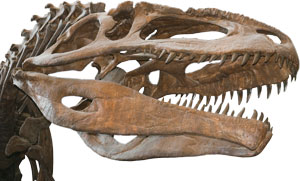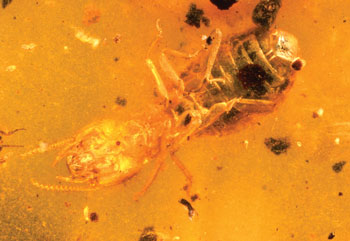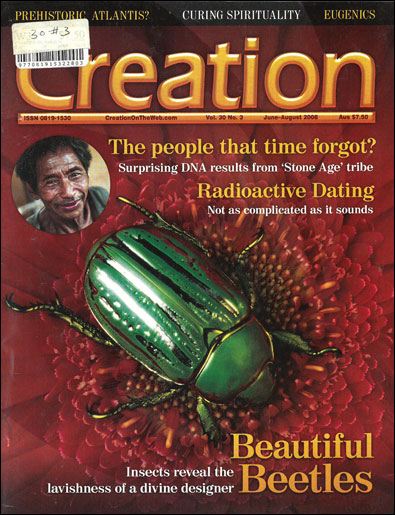The real ‘Jurassic Park’?

Dinosaur blood from a 65-million-year-old mosquito in amber used to clone live dinosaurs? It sounds like rather fanciful science fiction only fit for the movies, but claims reminiscent of Jurassic Park are becoming more common among scientists. We’re not talking about being able to resurrect dinosaurs from mosquitoes. However, claims abound that soft tissue, DNA and even entire bacteria ‘resurrected’ from a dormant state have survived for millions of years:
- Dino marrow. Mary Schweitzer has shown that T. rex bones ‘dated’ to 68 million years old have soft tissue in them, including the presence of blood cells, blood vessels and bone tissue (collagen).1
- Magnolia leaf DNA. This was extracted from a magnolia leaf fossil reported to be 17–20 million years old.2
- Bugs on ice. Bacteria frozen in Antarctica ‘dated’ to 8 million years old have been revived in the lab.3
- Amber bacteria. Some have claimed to have ‘resurrected’ dormant bacteria found in amber supposedly 120 million years old.4
- Salty microbes. A paper in Nature in 2000 claimed to have revived bacteria found in salt crystals from 600 m (2,000 ft) below the surface in a mine in Mexico ‘dated’ to 250 million years.5
The problems they face

Many of these reports have a lot of controversy surrounding them, and attract a lot of scepticism from other evolutionists. This is because biological molecules, such as DNA and collagen, are very complex and thus also rather fragile.3 They require constant maintenance to keep from breaking down. However, once the organism is dead, they are left to the mercy of the environment, and they usually decay very rapidly. If the molecules find themselves in an environment isolated from other life forms, water, oxygen and excessive heat, they will be able to survive longer, perhaps even thousands of years. However, they cannot last forever because they are still subject to the second law of thermodynamics,6 which will eventually break up the molecules purely through random motion of the atoms and background radiation. The most recent estimates place an upper limit of 125,000 years on the survival of DNA and 2.7 million years on collagen at 0°C.7 (At only 10°C, the upper limits are much less—17,500 for DNA, 180,000 for collagen.)
This is even more serious for functioning biological machinery than for isolated molecules such as DNA. Preserving biological molecules for millions of years is already farfetched.8 However, preserving functional life machinery for such time spans, with its far greater interconnected intricacies, as in the case of the salty microbes that were reanimated, is patently bizarre. How do evolutionists try to get around this conundrum?
‘Actualistic conditions’?
In seeking an answer, evolutionists of course maintain the millions-of-years framework as their ‘base assumption’. Mary Schweitzer demonstrates this regarding her 68 million-year-old T. rex finds:
‘The presence of original molecular components is not predicted for fossils older than a million years [refs.1–7] and the discovery of collagen in this well-preserved dinosaur supports the use of actualistic conditions to formulate molecular degradation rates and models, rather than relying on theoretical or experimental extrapolations derived from conditions that do not occur in nature.’9
This is the usual reasoning of those evolutionists who promote these finds, so let’s spell this out a bit. Firstly, notice what is predicted: based on scientific theory and experimental data, no collagen originally formed in the T. rex bone is expected to survive longer than a million years.

But Schweitzer then claims that this prediction should be questioned because we found exactly that (collagen originally formed in the T. rex bone) in a dinosaur bone. Schweitzer said elsewhere of her first finds of blood cells in T. rex bones: ‘I just got goose bumps, because everyone knows these things don’t last for 65 million years’ [emphasis added].10 This assumes that dinosaurs are ‘obviously’ (according to evolutionists) at least 65 million years old, which is exactly what they’re trying to prove! However, their assumption (that dinosaurs are more than 65 million years old) is completely at odds with the experimental data.
This is why Schweitzer says we should rely on ‘actualistic conditions’ rather than ‘theoretical or experimental extrapolations’ to tell how long collagen can last. We have to rethink our entire understanding of how complex biomolecules degrade—why? Because dinosaurs are ‘obviously’ millions of years old. The ‘millions of years’ belief trumps experimental science!
What about the accusation that the experimental and theoretical predictions made are not based on conditions that occur in nature? The very point of such projections is that they serve not as an average degradation time but as an upper limit.7 The experiments and theory therefore assume the best possible conditions for preservation. While such conditions are extremely unlikely to occur in nature, this is a hindrance to Schweitzer’s reasoning because the lab conditions are designed to be better than the preservation conditions normally found in nature, not worse. She requires the exact opposite to be true for her reasoning to be valid.
Many evolutionists see the problem. Having one’s cake and eating it too is simply not an option; they prefer to trust the experimental science. So, since they are committed to evolution and millions of years, it’s the idea that these bacteria, DNA, etc. have survived for millions of years that gets thrown out. Such things are then claimed to be contaminations from a modern source.
Were the finds contaminated?

However, the claims of contamination generally fail to deal with the specifics of each claim. A prime example is the finding of bacteria in salt crystals ‘dated’ to 250 million years. With each criticism, the original researchers rechecked their methods and modified them to take the criticisms into account, and still got the same results.11
Mary Schweitzer’s discovery of blood vessels, cells and bone collagen in T. rex bones presents another example. When it was first announced, it caused a lot of scepticism among evolutionists.12 In 2005, in the midst of strong scepticism toward the original findings, new images showed plainly that the soft tissue was ‘fresh’ organic tissue.13 Rigorous research was also conducted (again amid scepticism) that showed that the protein collagen, also a complex biomolecule, had been preserved in the T. rex bones as well.14
Contamination is always an option in theory, but when applied to at least some of the actual situations in question it doesn’t stand up under scrutiny. The obvious implications of the actual evidence at hand are that these finds are only thousands of years old at the most.
The Bible has the answer
Thus, the Bible makes a lot more sense of these ‘Jurassic Park fossils’. Preserving organic tissues for even thousands of years would require special conditions. It’s surprising that these sorts of remains are found about 4,500 years after they were buried (most likely during the Flood). But it makes far more sense than believing that the remains are millions of years old, which flies in the face of the real-world evidence of physics and chemistry.
References and notes
- Schweitzer, M.H., Suo, Z., Avci, R., Asara, J.M., Allen, M.A., Arce, F.T. and Horner, J.R., Analyses of soft tissue from Tyrannosaurus rex suggest the presence of protein, Science 316(5822):277–280, 2007. Return to text.
- Wieland, C., ‘Oldest’ DNA—an exciting find! Creation 13(2):22–23, 1991; <creation.com/oldestdna>. Return to text.
- Catchpoole, D., ‘Sleeping Beauty’ bacteria, Creation 28(1):23, 2005; <creation.com/sleeping>. See also Catchpoole, D., More ‘Sleeping Beauty’ bacteria, <creation.com/moresleep>. Return to text.
- Greenblatt, C.L., et al., Diversity of microorganisms isolated from amber, Microbial Ecology 38:58–68, 1999. Return to text.
- Vreeland, R.H., Rosenzweig, W.D. and Powers, D.W., Isolation of a 250 million-year-old halotolerant bacterium from a primary salt crystal, Nature 407(6806):897–900, 2000. See also Salty saga, Creation 23(4):15, 2001; <creation.com/saltysaga>. Return to text.
- See Sarfati, J., Second law of thermodynamics: answers to critics, <creation.com/thermo>. Return to text.
- Nielsen-Marsh, C., Biomolecules in fossil remains: Multidisciplinary approach to endurance, The Biochemist, pp. 12–14, June 2002; <www.biochemist.org/bio/02403/0012/024030012.pdf>. Return to text.
- Wieland, C., Ancient DNA and the young earth, Journal of Creation 8(1):7–10, 1994. Return to text.
- Ref. 1, p. 280. Return to text.
- Yeoman, B., Schweitzer’s dangerous discovery, Discover 27(4):37–41, 77, April 2006. Return to text.
- In 2001, the critics said that the bacterium found in the salt crystals was too closely related to modern bacteria and therefore had to be a modern contamination and not 250 million years old (Graur, D. and Pupko, T., The Permian bacterium that isn’t, Molecular Biology and Evolution 18(6):1143–1146, 2001).
However, the supporters countered that their data doesn’t mean much (Maughan, H., et al., The paradox of the ‘ancient’ bacterium which contains ‘modern’ protein-coding genes, Molecular Biology and Evolution 19(9):1637–1639, 2002). They’ve also supplied further evidence that the salt the bacterium was trapped in was formed around when the rock layer was formed and not a later inclusion (Satterfield, C.L. et al., New evidence for 250 Ma age of halotolerant bacterium from a Permian salt crystal, Geology 33(4):265–268, April 2005). Return to text. - Wieland, C., Sensational dinosaur blood report! Creation 19(4):42–43, 1997, <creation.com/dino_blood>. Return to text.
- Wieland, C., Still soft and stretchy, <creation.com/stretchy>, 25 March 2005. Return to text.
- Doyle, S., Squishosaur scepticism squashed, <creation.com/collagen>, 20 April 2007; see also <creation.com/schweit>. Return to text.




Readers’ comments
Comments are automatically closed 14 days after publication.